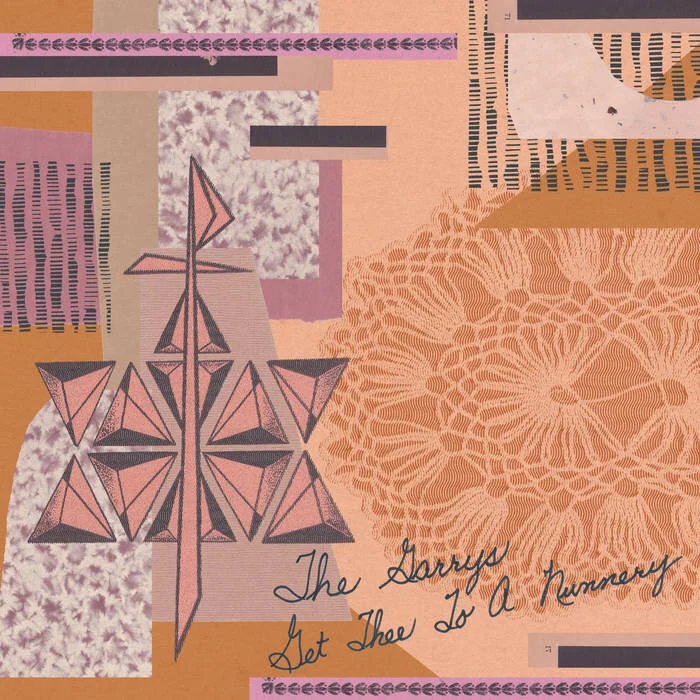The Garrys, Ada Lea, and Hubert Lenoir
The Garrys
Get Thee to a Nunnery // Grey Records
Many years ago at the Slice Bar & Grill, I came across a touring trio of sisters from Saskatchewan, traveling from the driest province in the country to the second-driest to play the most unexpected genre after that setup: 1960s west coast-style surf rock. That band was The Garrys, a group I’ve wished would come back to play in Lethbridge since then. Now it looks a little more possible for that wish to be fulfilled, thanks to the release of their new album Get Thee to a Nunnery.
Fellow fans of the band will be happy to know that Nunnery continues their signature aesthetic of classic California rock ‘n’ roll, combining the guitar tones and chord progressions of the era they pay homage to with the clear recording quality that modern technology makes possible and flashes of indie rock elements. Also back is perhaps the most distinguishing feature of the very best of the surf rock genre: their immaculately crafted and almost haunting vocal harmonies, which are especially satisfying as they close in on each other in tracks like “In the Dawn”.
Despite making music originally meant to be listened to at the beach on a warm summer’s day, The Garrys seem to have gone out of their way to choose the most ironic and inappropriate lyrical topics for the genre; and even the title of the instrumental “Hwy-11 Tumbleweed” has more associations with country or folk than it would anything to do with tunes for dipping your feet in ocean water. This stark contrast becomes most evident in “Bury Me with My Money”, a song about an outlaw that is once again more befitting of a country song; and especially in “Sintaluta”, which is about the Saskatchewan town of the same name during the dead of winter. The most pressing subject matter, however, is that of the title track and “Fallen Woman”, written as critiques of religious upbringing inspired by the sisters’ own family history. As the old saying goes, “Write about what you know,” which the band does brilliantly if only for the cognitive dissonance the music/lyrics comparison produces.
In the end, Get Thee to a Nunnery combines The Garrys’ familiar furthest-possible-thing-from-prairie-music sound and tongue-in-cheek lyricism with an increased focus on defying surf rock expectations by writing about life in one of our country’s most arid climates. If you’ve enjoyed The Garrys’ previous discography, you are guaranteed to enjoy this latest output of theirs. I certainly did.
- Ty Vanden Dool
Ada Lea
one hand on the steering wheel the other sewing a garden // Outside Music
I may sometimes be perceived as dramatic with my constant use of superlatives, but believe me when I say the grandiose words I use to describe the new Ada Lea record still barely do it justice. Montreal-based songwriter Ada Lea (Alexandra Levy) births one hand on the steering wheel the other sewing a garden, her sophomore album released with Outside Music. Combining the best parts of--quite literally--every genre, Ada Lea provides a familiarity that never slips into mundanity, a newness that never comes off pretentious, and a softness that never lacks assuredness. Each track of the album is single-worthy, yet their distinctness never detracts from one another when listened to as a whole. This album is worth listening to over, over, and over again.
Thirty seconds into the first track, “damn”, it’s easy to imagine this album at the top of the Best of 2021 lists. The laid-back 70’s soft-rock vibes leave plenty of room for the lyrics to shine, setting the scene of a New Year’s party gone wrong; clear and steady, Ada Lea recounts a night that just shouldn’t have happened, ending with a growing anthem that damns everything about that night “damn the party, damn the music, damn the phone that’s ringing…”. Upon first listen one might be tempted to suggest this is just another 70’s inspired good- vibes/easy-listening album, however as we hop into the second track we hear that Ada Lea’s sonic world is much larger than a few chorus guitars; “can’t stop me from dying” introduces edgier guitars and guarded vocals reminiscent of Metric circa 2005, then jumps back to the 70’s vibes on track 3, “oranges”; Ada Lea doesn’t put her songwriting in any boxes, jumping between traditional songwriting structures and absolutely unexpected key changes, tempo changes, and surprising instrumentation.
The album continues to take new form as we approach “saltspring”, track 5 on the album. Arriving at this song I said out loud “who produced this?!” I was pleasantly surprised to see this album was produced by Marshall Vore, popularly known as the drummer for Phoebe Bridgers. The production is truly a work of art; weaving in so many different musical styles is no easy feat, yet Vore strings each song together seamlessly with small lo-fi elements, dusty vocal effects, and of course chorus pedals.
As if the album isn’t incredible enough on its own, this album has an accompanying songbook with artwork by Ada Lea--she invites her followers into an immersive experience, allowing us to sing, play, dance, and feel along with her. It is also worth mentioning that three tracks have accompanying visuals which can be checked out at www.adaleamusic.com; these three videos are absolutely stunning, adding another layer to the communication of this album. It is easy to say that Ada Lea’s one hand on the steering wheel the other sewing a garden is an absolute masterpiece and must-listen.
- Lana Winterhalt
Hubert Lenoir
PICTURA DE IPSE : Musique directe // Simone Records/Terrible Records
After a memorable and divisive debut, Hubert Lenoir returns with, PICTURA DE IPSE: Musique Directe. A hodge-podge of ADHD bedlam that still manages to keep the rubber on the road, despite lacking clear direction. With collaborations including Mac Demarco (which is no surprise considering their shared propensity to get naked on stage), Polaris nods, recently signing Terrible Records, and praise from Canadian Music outlets calling him “a pop star in any language,” it’s becoming clear that he is on his way to becoming a fixture in the Canadian Music scene.
In his debut Darlène, Lenoir spun a fictional narrative sprawling the length of the album. PICTURA DE IPSE is still a conceptual album at heart, but with a looser approach and far more personal touches that come off as something made by and for Lenoir. In just 54 minutes he packs 20 songs full of personal details that may mean little to the listener on their own, but as a whole, Lenoir managed to make a surprisingly cohesive album out of something that should have been completely scattered. It’s like he put a puzzle together by smashing the pieces into all the wrong places until a completely new picture came into view.
Heading into the pandemic, Lenoir became interested in field recording and its potential in pop. Determined to find beauty and rhythm in everyday happenings, Lenoir injected the vulnerability of his own life and experiences into the album. It’s from these field recordings that Lenoir found rhythm to incorporate into the music. It’s a completely unique sound with personal touches that could have turned into a dreadful college dorm art disaster, but it’s clear that Lenoir possesses the creativity and maturity to elevate his work far beyond misguided exploration. Everything in PICTURA DE IPSE just works.
Snippets of facetime calls, late night lullabies, clips of media coverage, even Lenoir himself describing the very impetus and inspiration for the album: 1950s Quebec film documentary genre called Cinéma Directe. While that may seem like a tough niche to relate to, the listener’s understanding of it and Lenoir’s personal life means little. Lenoir does a fine job grabbing your hand and pulling you along through all the twists and turns of the controlled chaos of his mind and life as he explores some of the darker moments that followed harsh media coverage. All these personal touches, when met with flashes of hip-hop, R&B, Backstreet Boys, and electronic influences, creates a completely fresh take on pop.
Despite all the concepts underlying its direction, this album just sounds goddamn fantastic. It’s true that the music is truly magnetic, regardless of the language it’s performed in. It’s an exciting new direction for pop, and if Hubert Lenoir is the lodestar for Canadian pop music, I can’t wait.
- Clay Geddert



